Analysis of the English Legal System and Business Law Solutions
VerifiedAdded on 2024/06/05
|25
|4772
|352
Report
AI Summary
This report provides a comprehensive analysis of the English legal system and its application to business law. It explores the structure of the legal system, the role of government in law-making, and the sources of law that organizations must comply with, including statutory and common law. The report evaluates the effectiveness of the legal system and recent reforms, while also examining employers’ legal obligations related to occupational health and safety, harassment, and equal opportunities. Furthermore, it suggests appropriate legal solutions for various business problems, justifying these solutions with relevant statutes and case law. The report also assesses the positive and negative impacts of legal solutions and compares alternative legal advice, including alternative dispute resolution methods. This document is available on Desklib, a platform offering a wide range of study tools and resources for students.
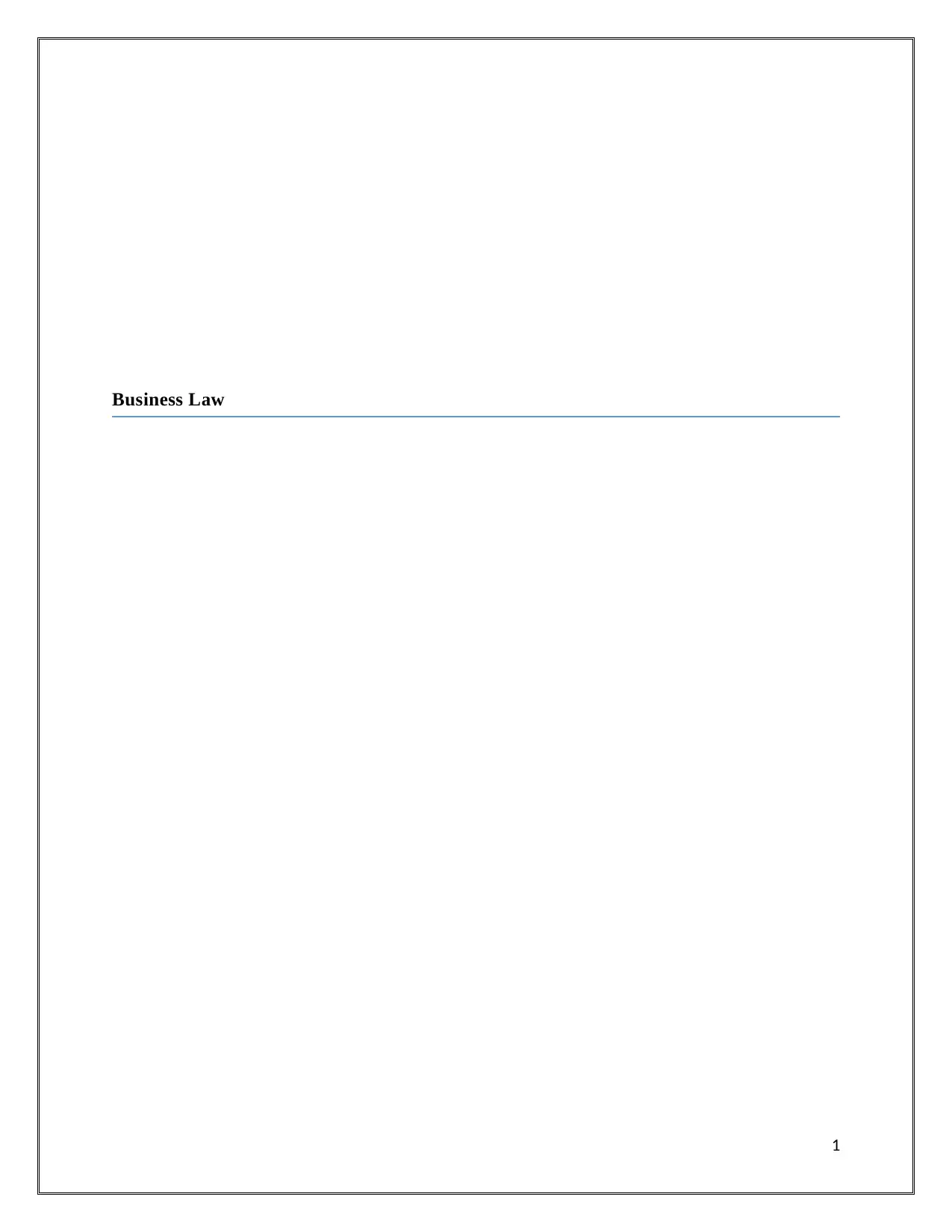
Business Law
1
1
Paraphrase This Document
Need a fresh take? Get an instant paraphrase of this document with our AI Paraphraser
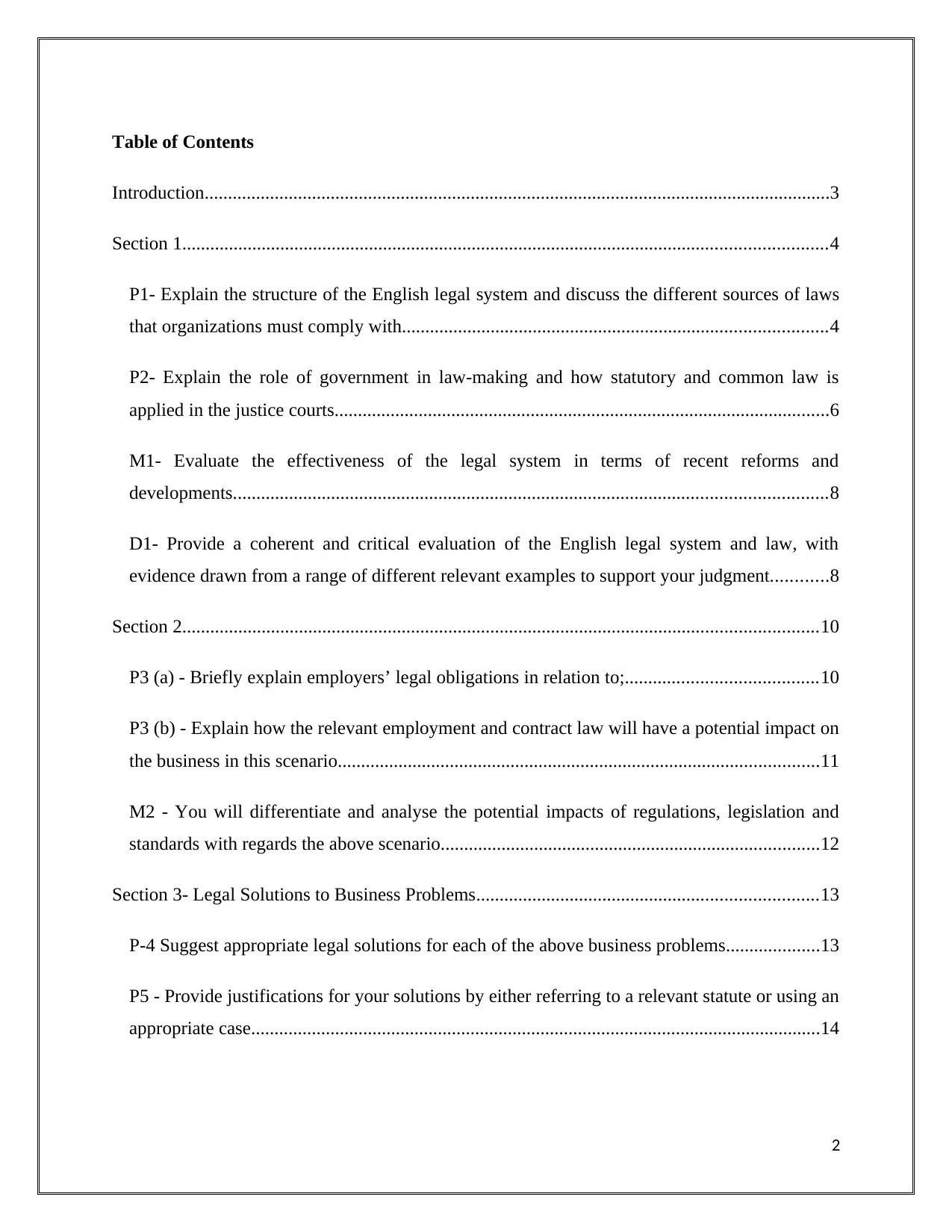
Table of Contents
Introduction......................................................................................................................................3
Section 1..........................................................................................................................................4
P1- Explain the structure of the English legal system and discuss the different sources of laws
that organizations must comply with...........................................................................................4
P2- Explain the role of government in law-making and how statutory and common law is
applied in the justice courts..........................................................................................................6
M1- Evaluate the effectiveness of the legal system in terms of recent reforms and
developments...............................................................................................................................8
D1- Provide a coherent and critical evaluation of the English legal system and law, with
evidence drawn from a range of different relevant examples to support your judgment............8
Section 2........................................................................................................................................10
P3 (a) - Briefly explain employers’ legal obligations in relation to;.........................................10
P3 (b) - Explain how the relevant employment and contract law will have a potential impact on
the business in this scenario.......................................................................................................11
M2 - You will differentiate and analyse the potential impacts of regulations, legislation and
standards with regards the above scenario.................................................................................12
Section 3- Legal Solutions to Business Problems.........................................................................13
P-4 Suggest appropriate legal solutions for each of the above business problems....................13
P5 - Provide justifications for your solutions by either referring to a relevant statute or using an
appropriate case..........................................................................................................................14
2
Introduction......................................................................................................................................3
Section 1..........................................................................................................................................4
P1- Explain the structure of the English legal system and discuss the different sources of laws
that organizations must comply with...........................................................................................4
P2- Explain the role of government in law-making and how statutory and common law is
applied in the justice courts..........................................................................................................6
M1- Evaluate the effectiveness of the legal system in terms of recent reforms and
developments...............................................................................................................................8
D1- Provide a coherent and critical evaluation of the English legal system and law, with
evidence drawn from a range of different relevant examples to support your judgment............8
Section 2........................................................................................................................................10
P3 (a) - Briefly explain employers’ legal obligations in relation to;.........................................10
P3 (b) - Explain how the relevant employment and contract law will have a potential impact on
the business in this scenario.......................................................................................................11
M2 - You will differentiate and analyse the potential impacts of regulations, legislation and
standards with regards the above scenario.................................................................................12
Section 3- Legal Solutions to Business Problems.........................................................................13
P-4 Suggest appropriate legal solutions for each of the above business problems....................13
P5 - Provide justifications for your solutions by either referring to a relevant statute or using an
appropriate case..........................................................................................................................14
2
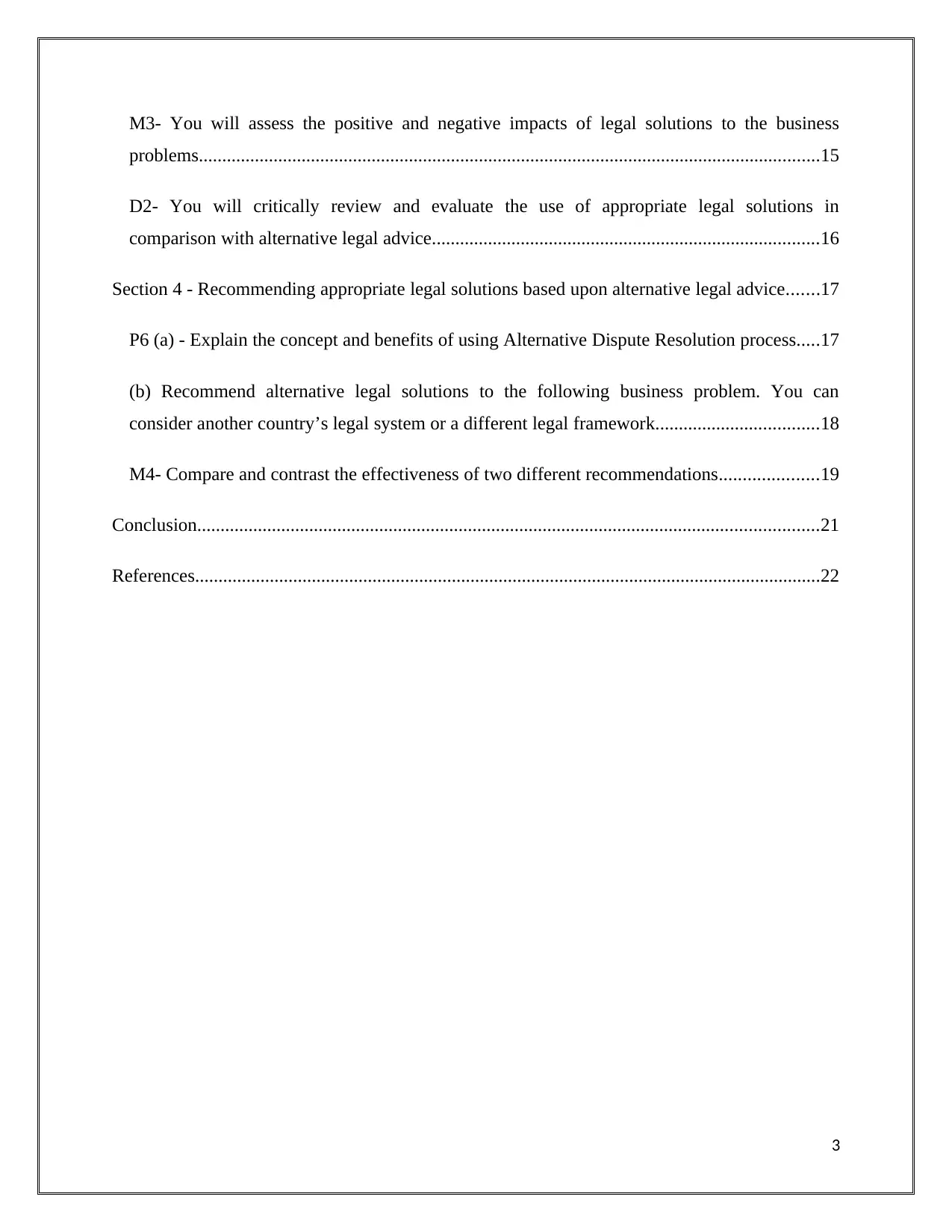
M3- You will assess the positive and negative impacts of legal solutions to the business
problems.....................................................................................................................................15
D2- You will critically review and evaluate the use of appropriate legal solutions in
comparison with alternative legal advice...................................................................................16
Section 4 - Recommending appropriate legal solutions based upon alternative legal advice.......17
P6 (a) - Explain the concept and benefits of using Alternative Dispute Resolution process.....17
(b) Recommend alternative legal solutions to the following business problem. You can
consider another country’s legal system or a different legal framework...................................18
M4- Compare and contrast the effectiveness of two different recommendations.....................19
Conclusion.....................................................................................................................................21
References......................................................................................................................................22
3
problems.....................................................................................................................................15
D2- You will critically review and evaluate the use of appropriate legal solutions in
comparison with alternative legal advice...................................................................................16
Section 4 - Recommending appropriate legal solutions based upon alternative legal advice.......17
P6 (a) - Explain the concept and benefits of using Alternative Dispute Resolution process.....17
(b) Recommend alternative legal solutions to the following business problem. You can
consider another country’s legal system or a different legal framework...................................18
M4- Compare and contrast the effectiveness of two different recommendations.....................19
Conclusion.....................................................................................................................................21
References......................................................................................................................................22
3
⊘ This is a preview!⊘
Do you want full access?
Subscribe today to unlock all pages.

Trusted by 1+ million students worldwide
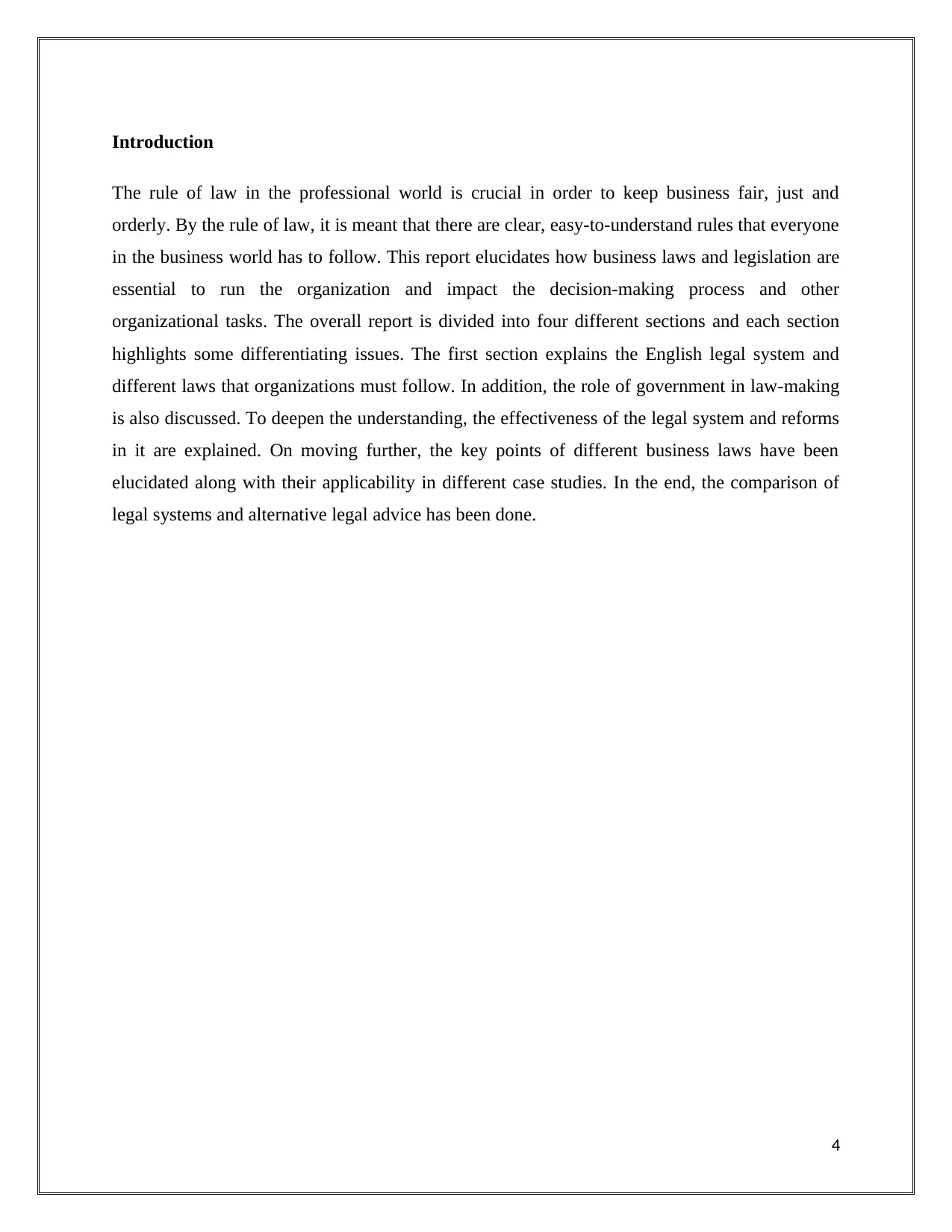
Introduction
The rule of law in the professional world is crucial in order to keep business fair, just and
orderly. By the rule of law, it is meant that there are clear, easy-to-understand rules that everyone
in the business world has to follow. This report elucidates how business laws and legislation are
essential to run the organization and impact the decision-making process and other
organizational tasks. The overall report is divided into four different sections and each section
highlights some differentiating issues. The first section explains the English legal system and
different laws that organizations must follow. In addition, the role of government in law-making
is also discussed. To deepen the understanding, the effectiveness of the legal system and reforms
in it are explained. On moving further, the key points of different business laws have been
elucidated along with their applicability in different case studies. In the end, the comparison of
legal systems and alternative legal advice has been done.
4
The rule of law in the professional world is crucial in order to keep business fair, just and
orderly. By the rule of law, it is meant that there are clear, easy-to-understand rules that everyone
in the business world has to follow. This report elucidates how business laws and legislation are
essential to run the organization and impact the decision-making process and other
organizational tasks. The overall report is divided into four different sections and each section
highlights some differentiating issues. The first section explains the English legal system and
different laws that organizations must follow. In addition, the role of government in law-making
is also discussed. To deepen the understanding, the effectiveness of the legal system and reforms
in it are explained. On moving further, the key points of different business laws have been
elucidated along with their applicability in different case studies. In the end, the comparison of
legal systems and alternative legal advice has been done.
4
Paraphrase This Document
Need a fresh take? Get an instant paraphrase of this document with our AI Paraphraser
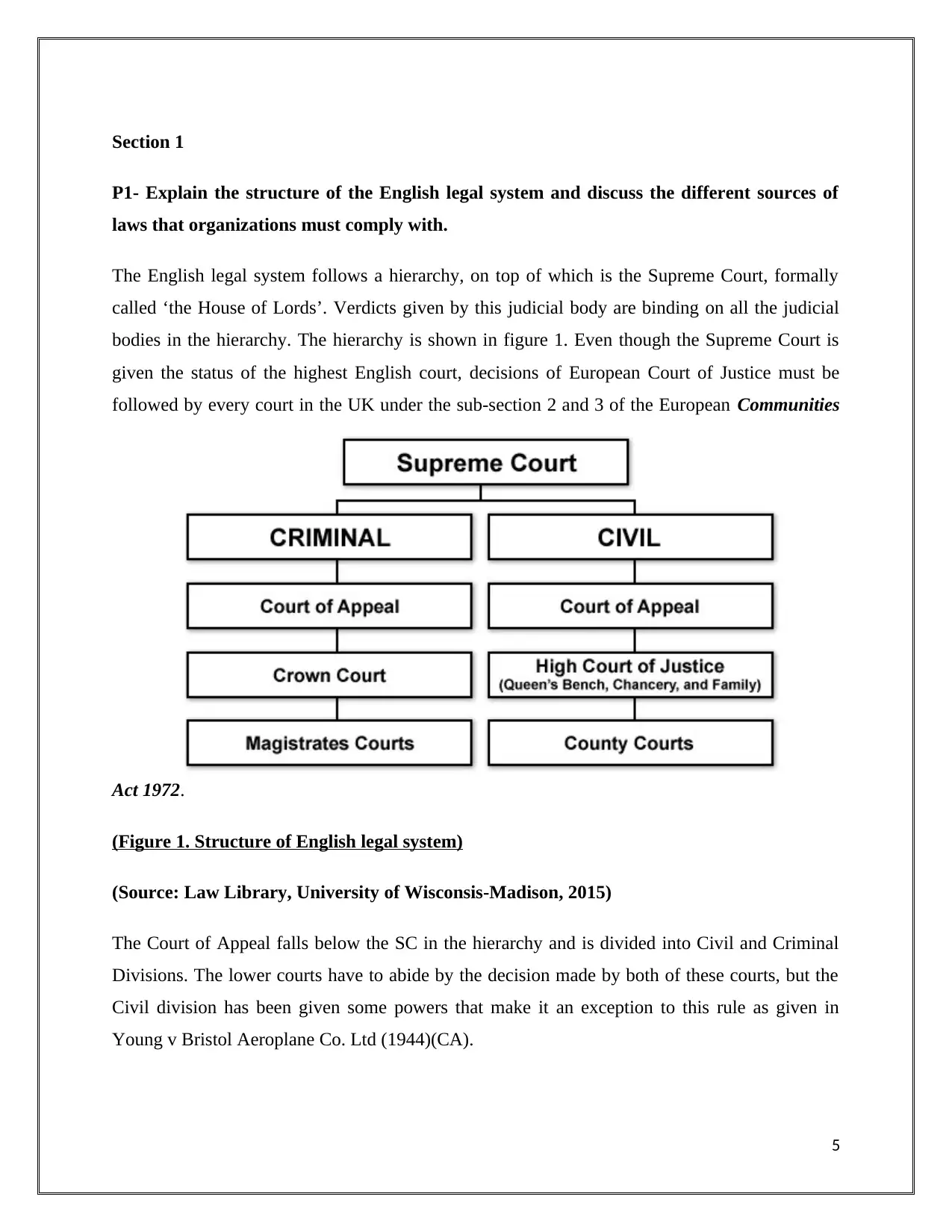
Section 1
P1- Explain the structure of the English legal system and discuss the different sources of
laws that organizations must comply with.
The English legal system follows a hierarchy, on top of which is the Supreme Court, formally
called ‘the House of Lords’. Verdicts given by this judicial body are binding on all the judicial
bodies in the hierarchy. The hierarchy is shown in figure 1. Even though the Supreme Court is
given the status of the highest English court, decisions of European Court of Justice must be
followed by every court in the UK under the sub-section 2 and 3 of the European Communities
Act 1972.
(Figure 1. Structure of English legal system)
(Source: Law Library, University of Wisconsis-Madison, 2015)
The Court of Appeal falls below the SC in the hierarchy and is divided into Civil and Criminal
Divisions. The lower courts have to abide by the decision made by both of these courts, but the
Civil division has been given some powers that make it an exception to this rule as given in
Young v Bristol Aeroplane Co. Ltd (1944)(CA).
5
P1- Explain the structure of the English legal system and discuss the different sources of
laws that organizations must comply with.
The English legal system follows a hierarchy, on top of which is the Supreme Court, formally
called ‘the House of Lords’. Verdicts given by this judicial body are binding on all the judicial
bodies in the hierarchy. The hierarchy is shown in figure 1. Even though the Supreme Court is
given the status of the highest English court, decisions of European Court of Justice must be
followed by every court in the UK under the sub-section 2 and 3 of the European Communities
Act 1972.
(Figure 1. Structure of English legal system)
(Source: Law Library, University of Wisconsis-Madison, 2015)
The Court of Appeal falls below the SC in the hierarchy and is divided into Civil and Criminal
Divisions. The lower courts have to abide by the decision made by both of these courts, but the
Civil division has been given some powers that make it an exception to this rule as given in
Young v Bristol Aeroplane Co. Ltd (1944)(CA).
5
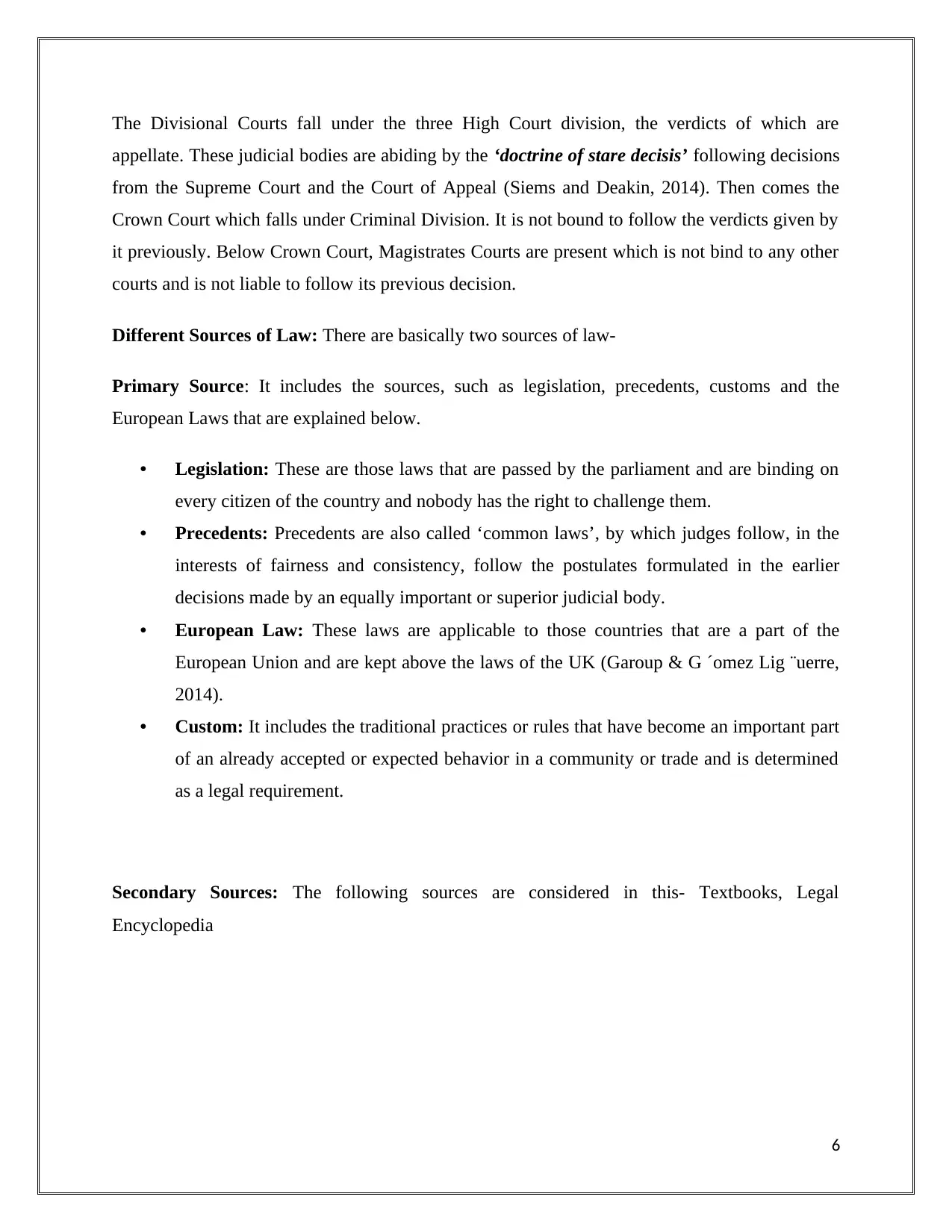
The Divisional Courts fall under the three High Court division, the verdicts of which are
appellate. These judicial bodies are abiding by the ‘doctrine of stare decisis’ following decisions
from the Supreme Court and the Court of Appeal (Siems and Deakin, 2014). Then comes the
Crown Court which falls under Criminal Division. It is not bound to follow the verdicts given by
it previously. Below Crown Court, Magistrates Courts are present which is not bind to any other
courts and is not liable to follow its previous decision.
Different Sources of Law: There are basically two sources of law-
Primary Source: It includes the sources, such as legislation, precedents, customs and the
European Laws that are explained below.
• Legislation: These are those laws that are passed by the parliament and are binding on
every citizen of the country and nobody has the right to challenge them.
• Precedents: Precedents are also called ‘common laws’, by which judges follow, in the
interests of fairness and consistency, follow the postulates formulated in the earlier
decisions made by an equally important or superior judicial body.
• European Law: These laws are applicable to those countries that are a part of the
European Union and are kept above the laws of the UK (Garoup & G ´omez Lig ¨uerre,
2014).
• Custom: It includes the traditional practices or rules that have become an important part
of an already accepted or expected behavior in a community or trade and is determined
as a legal requirement.
Secondary Sources: The following sources are considered in this- Textbooks, Legal
Encyclopedia
6
appellate. These judicial bodies are abiding by the ‘doctrine of stare decisis’ following decisions
from the Supreme Court and the Court of Appeal (Siems and Deakin, 2014). Then comes the
Crown Court which falls under Criminal Division. It is not bound to follow the verdicts given by
it previously. Below Crown Court, Magistrates Courts are present which is not bind to any other
courts and is not liable to follow its previous decision.
Different Sources of Law: There are basically two sources of law-
Primary Source: It includes the sources, such as legislation, precedents, customs and the
European Laws that are explained below.
• Legislation: These are those laws that are passed by the parliament and are binding on
every citizen of the country and nobody has the right to challenge them.
• Precedents: Precedents are also called ‘common laws’, by which judges follow, in the
interests of fairness and consistency, follow the postulates formulated in the earlier
decisions made by an equally important or superior judicial body.
• European Law: These laws are applicable to those countries that are a part of the
European Union and are kept above the laws of the UK (Garoup & G ´omez Lig ¨uerre,
2014).
• Custom: It includes the traditional practices or rules that have become an important part
of an already accepted or expected behavior in a community or trade and is determined
as a legal requirement.
Secondary Sources: The following sources are considered in this- Textbooks, Legal
Encyclopedia
6
⊘ This is a preview!⊘
Do you want full access?
Subscribe today to unlock all pages.

Trusted by 1+ million students worldwide

P2- Explain the role of government in law-making and how statutory and common law is
applied in the justice courts
In UK, the parliament is the greatest legislative authority that examines and checks the work of
the government. This legislature is responsible for making laws from the part of the government,
and debate upon their impact (Cotterrell, 2017). In UK, the parliament comprises the House of
Commons and the House of Lords. Before making a law, a bill is passed which is upvoted by
both the bodies. Before moving further, let’s understand each of the aforementioned bodies.
• House of Commons: This is the elected body of the parliament in which every member of the
Parliament is elected by the common people by themselves. They are elected to serve for the
period of five years and after every five years the election is held. Bills which are drafted by the
Government of UK are presented and supported by these people.
• House of Lords: The honorable Supreme Court is called the House of Lords. After the bill is
passed by the House of Commons, House of Lords reviews it and if there are any changes
needed, then it is made by the Supreme Court.
• Royal Assent: Since the Monarch is the head of the state, the final approval is taken from the
Monarch to pass the bill. This approval procedure is described in Royal Ascent Act 1961. After
getting approval of the Queen, the bill is notified in official gazette and become law (Partington,
2016).
Brief of Law-making Procedure:-
A complete procedure is described below briefly:
• A challenge emerges on the agendas formulated by government.
• Ideas for the same issue are considered.
• Interested experts and people are contacted.
• Cabinet ministers take forward the proposal
7
applied in the justice courts
In UK, the parliament is the greatest legislative authority that examines and checks the work of
the government. This legislature is responsible for making laws from the part of the government,
and debate upon their impact (Cotterrell, 2017). In UK, the parliament comprises the House of
Commons and the House of Lords. Before making a law, a bill is passed which is upvoted by
both the bodies. Before moving further, let’s understand each of the aforementioned bodies.
• House of Commons: This is the elected body of the parliament in which every member of the
Parliament is elected by the common people by themselves. They are elected to serve for the
period of five years and after every five years the election is held. Bills which are drafted by the
Government of UK are presented and supported by these people.
• House of Lords: The honorable Supreme Court is called the House of Lords. After the bill is
passed by the House of Commons, House of Lords reviews it and if there are any changes
needed, then it is made by the Supreme Court.
• Royal Assent: Since the Monarch is the head of the state, the final approval is taken from the
Monarch to pass the bill. This approval procedure is described in Royal Ascent Act 1961. After
getting approval of the Queen, the bill is notified in official gazette and become law (Partington,
2016).
Brief of Law-making Procedure:-
A complete procedure is described below briefly:
• A challenge emerges on the agendas formulated by government.
• Ideas for the same issue are considered.
• Interested experts and people are contacted.
• Cabinet ministers take forward the proposal
7
Paraphrase This Document
Need a fresh take? Get an instant paraphrase of this document with our AI Paraphraser
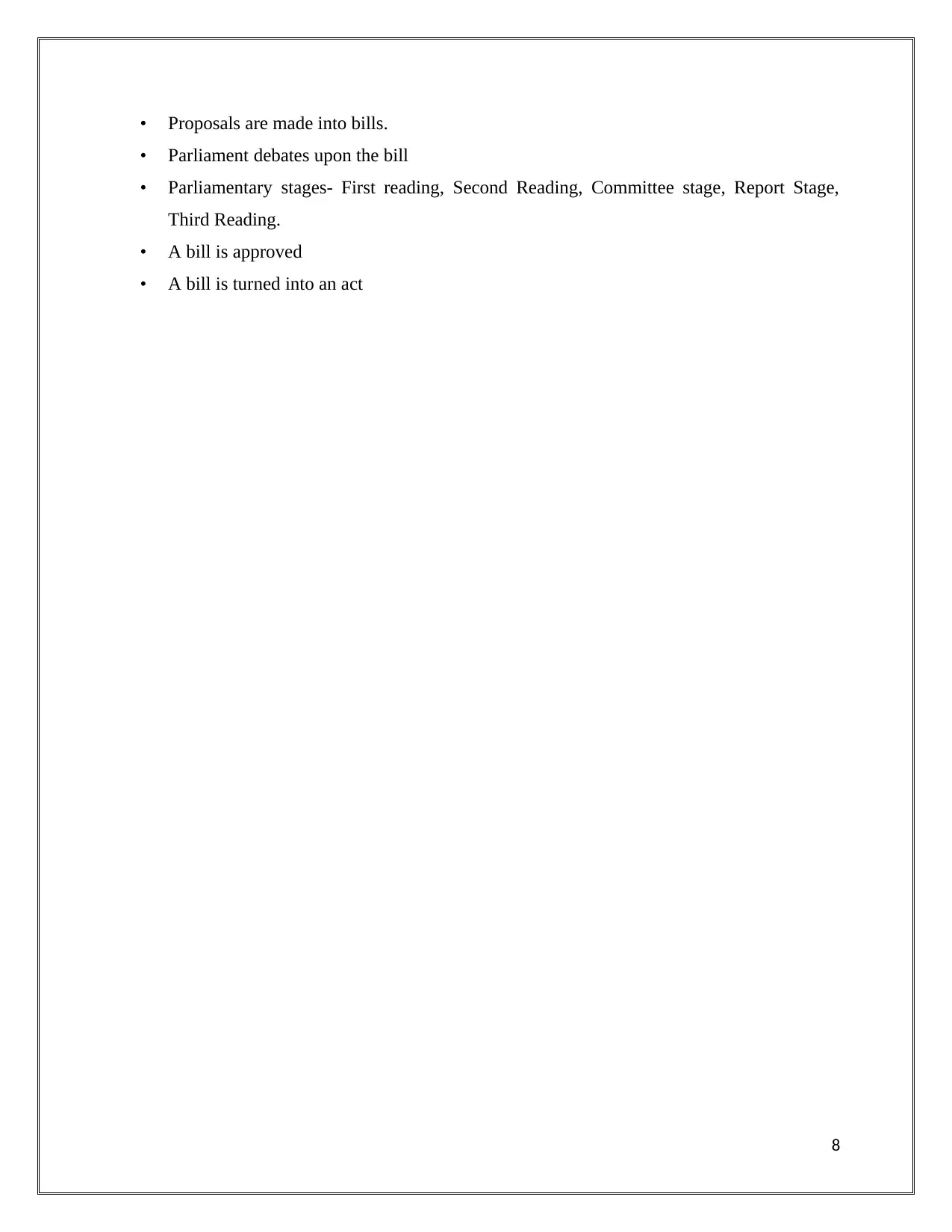
• Proposals are made into bills.
• Parliament debates upon the bill
• Parliamentary stages- First reading, Second Reading, Committee stage, Report Stage,
Third Reading.
• A bill is approved
• A bill is turned into an act
8
• Parliament debates upon the bill
• Parliamentary stages- First reading, Second Reading, Committee stage, Report Stage,
Third Reading.
• A bill is approved
• A bill is turned into an act
8
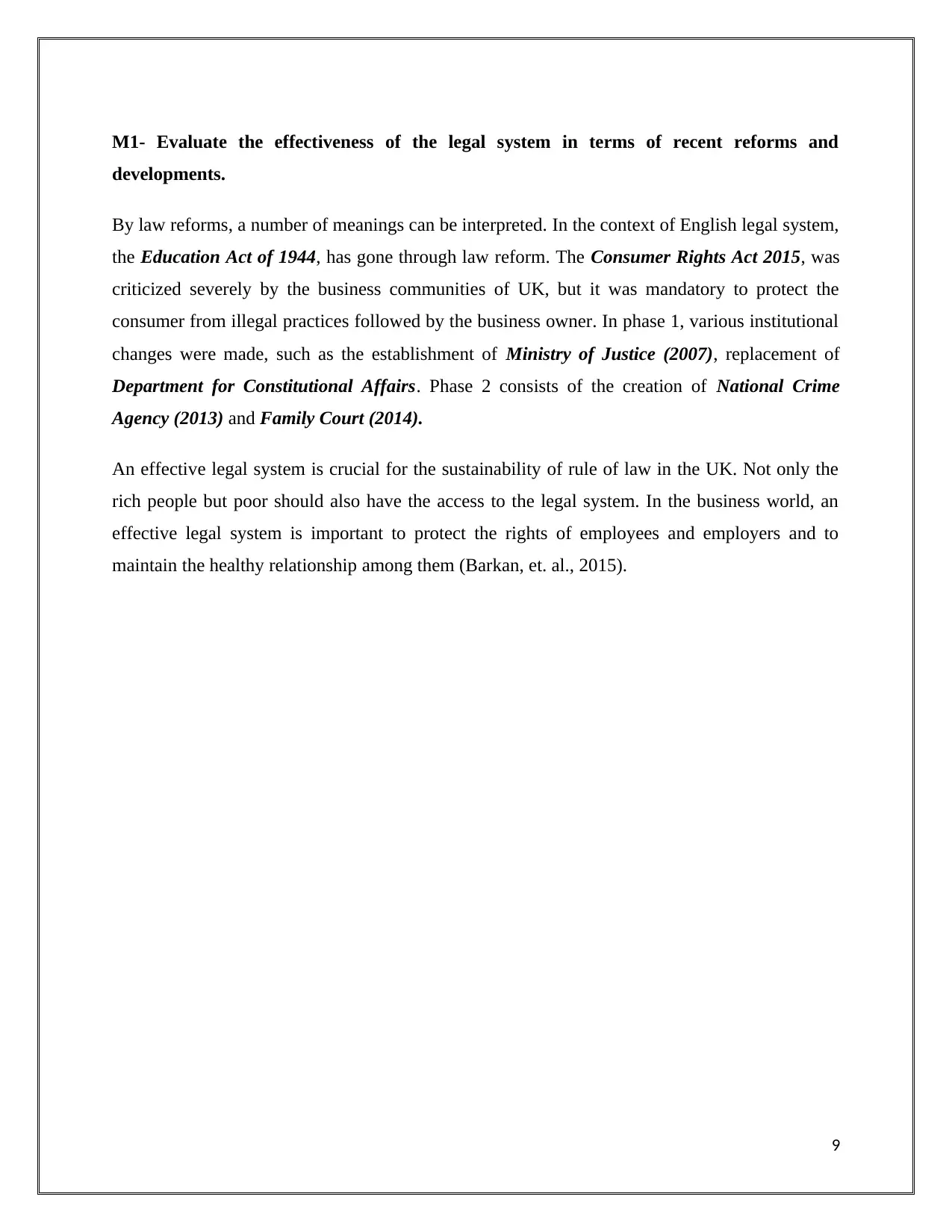
M1- Evaluate the effectiveness of the legal system in terms of recent reforms and
developments.
By law reforms, a number of meanings can be interpreted. In the context of English legal system,
the Education Act of 1944, has gone through law reform. The Consumer Rights Act 2015, was
criticized severely by the business communities of UK, but it was mandatory to protect the
consumer from illegal practices followed by the business owner. In phase 1, various institutional
changes were made, such as the establishment of Ministry of Justice (2007), replacement of
Department for Constitutional Affairs. Phase 2 consists of the creation of National Crime
Agency (2013) and Family Court (2014).
An effective legal system is crucial for the sustainability of rule of law in the UK. Not only the
rich people but poor should also have the access to the legal system. In the business world, an
effective legal system is important to protect the rights of employees and employers and to
maintain the healthy relationship among them (Barkan, et. al., 2015).
9
developments.
By law reforms, a number of meanings can be interpreted. In the context of English legal system,
the Education Act of 1944, has gone through law reform. The Consumer Rights Act 2015, was
criticized severely by the business communities of UK, but it was mandatory to protect the
consumer from illegal practices followed by the business owner. In phase 1, various institutional
changes were made, such as the establishment of Ministry of Justice (2007), replacement of
Department for Constitutional Affairs. Phase 2 consists of the creation of National Crime
Agency (2013) and Family Court (2014).
An effective legal system is crucial for the sustainability of rule of law in the UK. Not only the
rich people but poor should also have the access to the legal system. In the business world, an
effective legal system is important to protect the rights of employees and employers and to
maintain the healthy relationship among them (Barkan, et. al., 2015).
9
⊘ This is a preview!⊘
Do you want full access?
Subscribe today to unlock all pages.

Trusted by 1+ million students worldwide

10
Paraphrase This Document
Need a fresh take? Get an instant paraphrase of this document with our AI Paraphraser
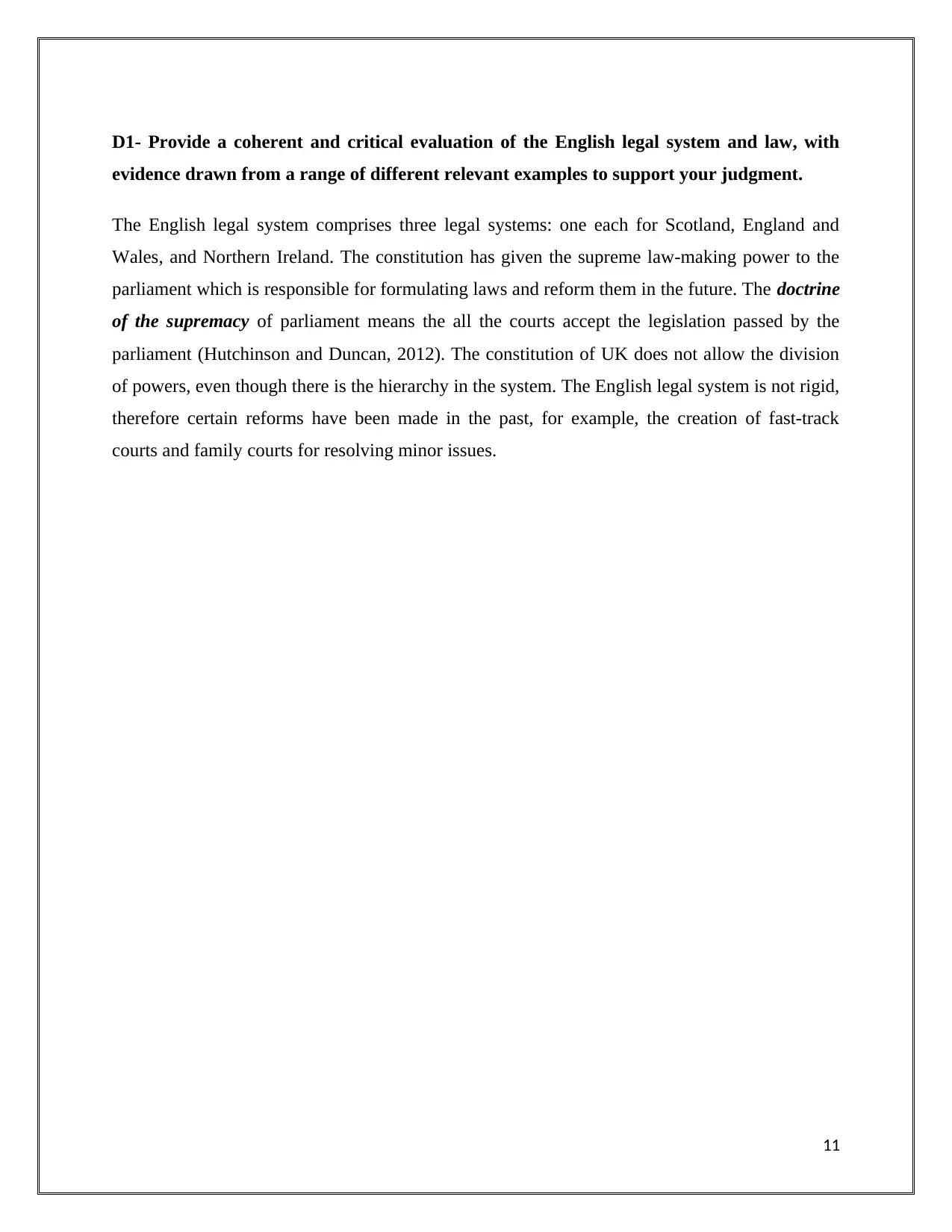
D1- Provide a coherent and critical evaluation of the English legal system and law, with
evidence drawn from a range of different relevant examples to support your judgment.
The English legal system comprises three legal systems: one each for Scotland, England and
Wales, and Northern Ireland. The constitution has given the supreme law-making power to the
parliament which is responsible for formulating laws and reform them in the future. The doctrine
of the supremacy of parliament means the all the courts accept the legislation passed by the
parliament (Hutchinson and Duncan, 2012). The constitution of UK does not allow the division
of powers, even though there is the hierarchy in the system. The English legal system is not rigid,
therefore certain reforms have been made in the past, for example, the creation of fast-track
courts and family courts for resolving minor issues.
11
evidence drawn from a range of different relevant examples to support your judgment.
The English legal system comprises three legal systems: one each for Scotland, England and
Wales, and Northern Ireland. The constitution has given the supreme law-making power to the
parliament which is responsible for formulating laws and reform them in the future. The doctrine
of the supremacy of parliament means the all the courts accept the legislation passed by the
parliament (Hutchinson and Duncan, 2012). The constitution of UK does not allow the division
of powers, even though there is the hierarchy in the system. The English legal system is not rigid,
therefore certain reforms have been made in the past, for example, the creation of fast-track
courts and family courts for resolving minor issues.
11

Section 2
P3 (a) - Briefly explain employers’ legal obligations in relation to;
(i) Occupational Health and Safety
The employer’s obligations include the following:-
The provisions of maintenance of machineries and plant or systems that are
reasonably safe, practicable, and risk-free.
The provisions for a safe and risk-free handling, storing, and transporting
substances.
Provisions for providing educations, training, guidance, setting a benchmark,
essential for the safety of workers (Russ, 2012).
Provisions of providing arrangements for the welfare at work for employees.
(ii) Workers Compensation
Workers compensation is a reimbursement provided by the employer to those
employees who incurred certain injuries while working on the site. The obligations
includes:-
Providing immediate medical aid to the injured person.
Formulating a report of the whole incidence and submitting it in the nearby
worker’s compensation board office.
Comply with the changes suggested by the worker’s compensation board or the
insurance company.
(iii) Harassment
According to the Protection from Harassment Act 1997, it is the key responsibility
of the employer to make sure that any type of harassment, such as physical, mental or
verbal does not occur in the workplace as employees’ safety and welfare are his/her
sole responsibility. If any of such unethical events occurred in the future, then he/she
will be held responsible for such events.
(iv) Equal Opportunities
12
P3 (a) - Briefly explain employers’ legal obligations in relation to;
(i) Occupational Health and Safety
The employer’s obligations include the following:-
The provisions of maintenance of machineries and plant or systems that are
reasonably safe, practicable, and risk-free.
The provisions for a safe and risk-free handling, storing, and transporting
substances.
Provisions for providing educations, training, guidance, setting a benchmark,
essential for the safety of workers (Russ, 2012).
Provisions of providing arrangements for the welfare at work for employees.
(ii) Workers Compensation
Workers compensation is a reimbursement provided by the employer to those
employees who incurred certain injuries while working on the site. The obligations
includes:-
Providing immediate medical aid to the injured person.
Formulating a report of the whole incidence and submitting it in the nearby
worker’s compensation board office.
Comply with the changes suggested by the worker’s compensation board or the
insurance company.
(iii) Harassment
According to the Protection from Harassment Act 1997, it is the key responsibility
of the employer to make sure that any type of harassment, such as physical, mental or
verbal does not occur in the workplace as employees’ safety and welfare are his/her
sole responsibility. If any of such unethical events occurred in the future, then he/she
will be held responsible for such events.
(iv) Equal Opportunities
12
⊘ This is a preview!⊘
Do you want full access?
Subscribe today to unlock all pages.

Trusted by 1+ million students worldwide
1 out of 25
Related Documents
Your All-in-One AI-Powered Toolkit for Academic Success.
+13062052269
info@desklib.com
Available 24*7 on WhatsApp / Email
![[object Object]](/_next/static/media/star-bottom.7253800d.svg)
Unlock your academic potential
Copyright © 2020–2025 A2Z Services. All Rights Reserved. Developed and managed by ZUCOL.




